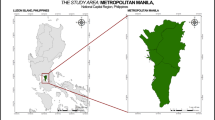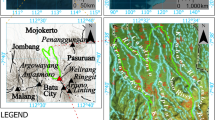Abstract
CARTOSAT-1-derived 10 m spatial resolution digital elevation model (DEM) for entire India was compiled for several applications. Overall assessment of the accuracy of this product requires additional regional studies involving ground truth control points and accuracy verification methods with a higher level of precision, such as the global positioning system (GPS).The study presented in this paper compares the accuracy of CARTOSAT-1 datasets with respect to eight sites over different terrains in India with the same GPS system. Robust statistical analysis including mean errors, standard deviation error, root mean square error (RMSE), skewness, kurtosis measures and Shapiro–Wilk’s normality test were used for evaluating error. The results of this study show a linear trend between the DEM and the ground control points (GCP). The mean error is very high in highlands ranging up to − 14.06 m, whereas in moderate terrain it ranges around 2.65 m and in the lowland about 1.20 m. RMSE ranges up to 28.82 m in rugged high-altitude topographies, 6.24 m in moderate and 1.98 m in low-altitude regions. However, this study shows that CARTODEM is one of the finest DEM that can be used for the Indian subcontinent as it works more accurately over plain and moderately undulating lands.



Similar content being viewed by others
References
Ahmed N, Mahtab A, Agrawal R, Jayaprasad P, Pathan SK, Singh DK, Singh AK (2007) Extraction and validation of CARTOSAT-1 DEM. J Indian Soc Remote Sens 35(2):121–127
ASPRS Lidar Committee (2004) ASPRS guidelines vertical accuracy reporting for lidar data. http://www.asprs.org/society/committees/lidar/Downloads/ Accessed 28 Jan 2009, p 20
Baral SS, Das J, Saraf AK, Borgohain S, Singh G (2016) Comparison of CARTOSAT, ASTER and SRTM DEMs of different terrains. Asian J Geoinform 16(1)
Cai X, Wang D (2006) Spatial autocorrelation of topographic index in catchments. J Hydrol 328(3–4):581–591
Chang KT, Tsai BW (1991) The effect of DEM resolution on slope and aspect mapping. Cartogr Geogr Inf Syst 18(1):69–77
Chappell NA, Sukanya V, Jiang Y, Nipon T (2006) Return-flow prediction and buffer designation in two rainforest headwaters. For Ecol Manag 224(1–2):131–146
Chen Y, Shi P, Li J, Deng L, Hu D, Fan Y (2007) DEM accuracy comparison between different models from different stereo pairs. Int J Remote Sens 28(19):4217–4224
Cuartero A, Felicisimo AM, Ariza FJ (2005) Accuracy, reliability, and depuration of SPOT HRV and Terra ASTER digital elevation models. IEEE Trans Geosci Remote Sens 43(2):404–407
De Oliveira CG, Paradella WR (2008) An assessment of the altimetric information derived from spaceborne SAR (RADARSAT-1, SRTM3) and optical (ASTER) data for cartographic application in the Amazon region. Sensors 8(6):3819–3829
Deilami K, Mohd S, Bin MI, Atashpareh N (2012) An accuracy assessment of ASTER stereo images-derived digital elevation model by using rational polynomial coefficient model. Am J Sci Res 55:128–135
Favey E, Geiger A, Gudmundsson GH, Wehr A (1999) Evaluating the potential of an airborne laser-scanning system for measuring volume changes of glaciers. GeografiskaAnnaler 81(4):555–561
Fisher PF, Tate NJ (2006) Causes and consequences of error in digital elevation models. Prog Phys Geogr 30(4):467–489
Florinsky IV (1998) Accuracy of local topographic variables derived from digital elevation models. Int J Geogr Inf Sci 12(1):47–61
Fraser CS, Baltsavias E, Gruen A (2002) Processing of Ikonos imagery for submetre 3D positioning and building extraction. ISPRS J Photogramm Remote Sens 56(3):177–194
Giribabu D, Rao SS, Murthy YK (2013a) Improving CARTOSAT-1 DEM accuracy using synthetic stereo pair and triplet. ISPRS J Photogramm Remote Sens 77:31–43
Giribabu D, Kumar P, Mathew J, Sharma KP, Murthy YK (2013b) DEM generation using CARTOSAT-1 stereo data: issues and complexities in Himalayan terrain. Eur J Remote Sens 46(1):431–443
Herring TA, King RW, McClusky SC (2010) Introduction to Gamit/Globk. Massachusetts Institute of Technology, Cambridge
Holmes KW, Chadwick OA, Kyriakidis PC (2000) Error in a USGS 30-meter digital elevation model and its impact on terrain modeling. J Hydrol 233(1–4):154–173
Iwahashi J, Watanabe S, Furuya T (2003) Mean slope-angle frequency distribution and size frequency distribution of landslide masses in Higashikubiki area, Japan. Geomorphology 50(4):349–364
Jain SK, Singh VP (2003) Water resources systems planning and management, vol 51. Elsevier, Amsterdam
Kervyn F (2001) Modelling topography with SAR interferometry: illustrations of a favourable and less favourable environment. Comput Geosci 27(9):1039–1050
Li J, Chapman MA, Sun X (2006) Validation of satellite-derived digital elevation models from in-track IKONOS stereo imagery. Ontario Ministry of Transport, Toronto
Mukherjee S, Joshi PK, Mukherjee S, Ghosh A, Garg RD, Mukhopadhyay A (2013) Evaluation of vertical accuracy of open source Digital Elevation Model (DEM). Int J Appl Earth Obs Geoinf 21:205–217
Mukherjee S, Mukherjee S, Bhardwaj A, Mukhopadhyay A, Garg RD, Hazra S (2015) Accuracy of CARTOSAT-1 DEM and its derived attribute at multiple scale representation. J Earth Syst Sci 124(3):487–495
Muralikrishnan S, Kumar AS, Manjunath AS, Rao KMM (2006) Geometric quality assessment of CARTOSAT-1 data products. Int Archs Photogram Remote Sens 36(4)
Peng X, Wang J, Zhang Q (2005) Deriving terrain and textural information from stereo RADARSAT data for mountainous land cover mapping. Int J Remote Sens 26(22):5029–5049
Peng H, Liu X, Hai H (2009) Accuracy assessment of digital elevation models based on approximation theory. Photogramm Eng Remote Sens 75(1):49–56
Qi H, Altinakar MS (2011) A GIS-based decision support system for integrated flood management under uncertainty with two dimensional numerical simulations. Environ Model Softw 26(6):817–821
Ramlal B, Baban SM (2008) Developing a GIS based integrated approach to flood management in Trinidad, West Indies. J Environ Manag 88(4):1131–1140
Rawat KS, Mishra AK, Sehgal VK, Ahmed N, Tripathi VK (2013) Comparative evaluation of horizontal accuracy of elevations of selected ground control points from ASTER and SRTM DEM with respect to CARTOSAT-1 DEM: a case study of Shahjahanpur district, Uttar Pradesh, India. Geocarto Int 28(5):439–452
Rodriguez E, Morris CS, Belz JE (2006) A global assessment of the SRTM performance. Photogramm Eng Remote Sens 72(3):249–260
Romanowicz RJ, Young PC, Beven KJ, Pappenberger F (2008) A data based mechanistic approach to nonlinear flood routing and adaptive flood level forecasting. Adv Water Resour 31(8):1048–1056
San BT, Suzen ML (2005) Digital elevation model (DEM) generation and accuracy assessment from ASTER stereo data. Int J Remote Sens 26(22):5013–5027
Schenk T (1996) Digital aerial triangulation. Int Arch Photogramm Remote Sens 31:735–745
Shaphiro SS, Wilk MB (1965) An analysis of variance test for normality. Biometrika 52(3):591–611
Spark RN, Williams PF (1996) Digital terrain models and the visualization of structural geology. In: Computer methods in the geosciences, vol 15. Pergamon, pp 421–446
Tarboton DG (1997) A new method for the determination of flow directions and upslope areas in grid digital elevation models. Water Resour Res 33(2):309–319
Theobald DM (1989) Accuracy and bias issues in surface representation. Accuracy Spat Databases 99–106
Toutin T (2002) Impact of terrain slope and aspect on radargrammetric DEM accuracy. ISPRS J Photogramm Remote Sens 57(3):228–240
Toutin T (2004) DSM generation and evaluation from QuickBird stereo imagery with 3D physical modelling. Int J Remote Sens 25(22):5181–5192
Toutin T (2008) ASTER DEMs for geomatic and geoscientific applications: a review. Int J Remote Sens 29(7):1855–1875
Vassilopoulou S, Hurni L, Dietrich V, Baltsavias E, Pateraki M, Lagios E, Parcharidis I (2002) Orthophoto generation using IKONOS imagery and high-resolution DEM: a case study on volcanic hazard monitoring of Nisyros Island (Greece). ISPRS J Photogramm Remote Sens 57(1–2):24–38
Wilson JP, Gallant JC (2000) Secondary topographic attributes. Terrain Anal 87–131
Weibel R, Heller M (1990) A framework for digital terrain modeling. In: 4th international symposium on spatial data handling. Zurich, Switzerland
Acknowledgements
The authors are sincerely thankful to Deepak Das, Director, Space Applications Centre (ISRO), Ahmedabad, and Dr. Raj Kumar, Deputy Director EPSA, Space Applications Centre, ISRO, for their encouragement during the study. One of the authors, Ms. Koyel Sur, would like to acknowledge the DOS-sponsored fellowship for carrying out this research study.
Author information
Authors and Affiliations
Corresponding author
Additional information
Publisher's Note
Springer Nature remains neutral with regard to jurisdictional claims in published maps and institutional affiliations.
Rights and permissions
About this article
Cite this article
Agarwal, R., Sur, K. & Rajawat, A.S. Accuracy assessment of the CARTOSAT DEM using robust statistical measures. Model. Earth Syst. Environ. 6, 471–478 (2020). https://doi.org/10.1007/s40808-019-00694-9
Received:
Accepted:
Published:
Issue Date:
DOI: https://doi.org/10.1007/s40808-019-00694-9




